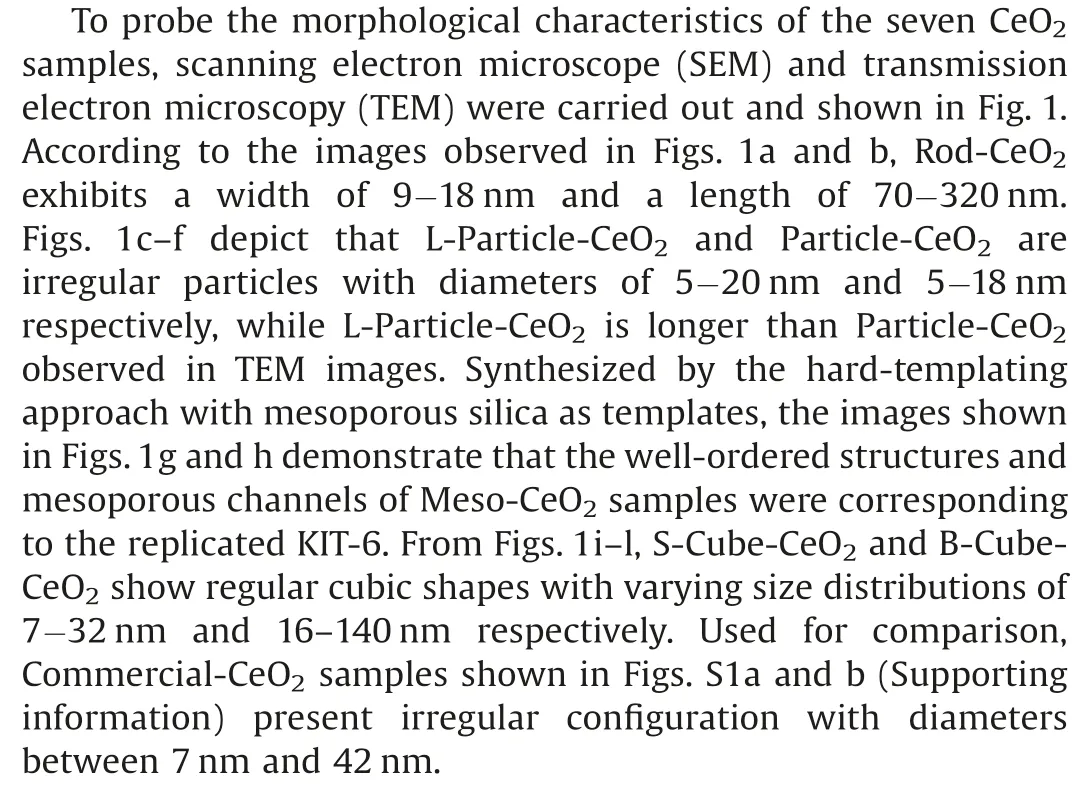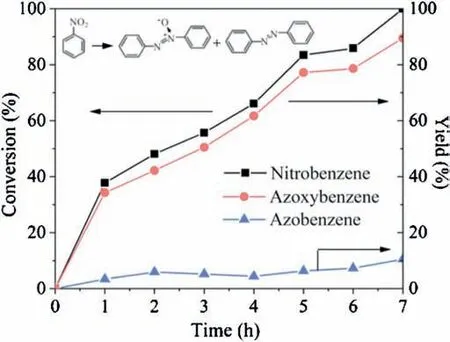The relationship of morphology and catalytic performance of CeO2catalysts for reducing nitrobenzene to azoxybenzene under the base-free condition
2021-05-14XuekeZhouHaitaoZhaoShaojunLiuYangYangRuiyangQuChenghangZhenXiangGao
Xueke Zhou,Haitao Zhao,Shaojun Liu,Yang Yang,Ruiyang Qu,Chenghang Zhen,Xiang Gao*
State Key Lab of Clean Energy Utilization, State Environmental Protection Engineering Center for Coal-Fired Air Pollution Control, Zhejiang University,Hangzhou 310027, China
ABSTRACT CeO2morphology was proposed to be a crucial factor for reducing nitrobenzene to azoxybenzene under the base-free condition.Herein, the structure-activity relationship of CeO2catalysts was explored to improve the azoxybenzene yield.A series of CeO2catalysts were synthesized with seven morphologies to obtain different Ce3+proportion and various surface areas.Notably, the catalytic performance of these samples for reducing nitrobenzene to azoxybenzene enhanced with the increasing Ce3+proportion.With the highest surface Ce3+proportion, the Rod-CeO2catalyst exhibited 100% conversion of nitrobenzene and 89.8% azoxybenzene selectivity in 7 h at 150under 1 MPa CO.Moreover, the preliminary mechanistic analysis indicated that the inhabitation of azoxybenzene to by-product azobenzene resulted in the high selectivity of azoxybenzene.
Keywords:Ceria catalyst Ce3+proportion Nitrobenzene Azoxybenzene Base-free
Azoxybenzene is a high-value compound with wide applications in chemical industries as dyes, pigments and agrochemicals[1,2].Azoxybenzene is commonly obtained by oxidation of aniline or reduction of nitrobenzene as an intermediate [3,4].The conventional production of azoxybenzene entails condensation of stoichiometric nitrosobenzene and hydroxylamine [5].This process lacks of atom-economy and produces by-products which cause pollution troubles.To simply the reaction steps and prevent the production of hazardous by-products, the development of controlling the selectivity in the midst of nitrobenzene reduction to produce azoxybenzene is of ongoing research interest.
Recently, there are some developments reported to achieve satisfying yields of azoxybenzene in the presence of bases such as hydrazine hydrate or NaOH by transferring the reduction route of intermediate formed from nitrobenzene hydrogenation [6–8].However,the green synthesis of azoxybenzene under the base-free condition is still a challenge.Another interesting finding is that azoxybenzene could be produced under the base-free condition catalyzed by Ni@C+CeO2[9].In this research,the combination of Ni@C and CeO2exhibited the best catalytic performance to synthesize azoxybenzene compared with combinations of Ni@C with metal oxides such as Al2O3, TiO2, SiO2, which indicated that CeO2was crucial for the high yield of azoxybenzene.However,the structure-activity relationship of CeO2catalysts remain to be explored.For CeO2based catalysts,the cyclic alternation between Ce3+and Ce4+and the oxygen storage capacity(OSC)are regarded as the key ingredients in reactions such as hydrogenation[10],HgO oxidation[11],hydrogen generation[12],CO oxidation[13,14]and so on.As shown in the report of azobenzene synthesis by reducing nitrobenzene, the BET surface areas of Au/CeO2catalysts, which were related to the oxygen storage capacity,exhibited a correlation with the catalytic activities of reducing azoxybenzene to azobenzene[15].However,the key effect factor for reducing nitrobenzene to azoxybenzene catalyzed by CeO2based catalysts has not been proposed.
Considering that the morphology engineering of CeO2is of great importance to control their surface chemistry[16–18],herein,we synthesized a series of CeO2samples with seven morphologies and applied them in reducing nitrobenzene to azoxybenzene.The relationship of physico-chemical properties of the seven CeO2catalysts and their catalytic performance was explored to improve azoxybenzene yield under the base-free condition.
In this work, the Rod-CeO2, B-Cube-CeO2and S-Cube-CeO2samples were prepared via hydrothermal methods.Particle-CeO2was synthesized by precipitation method.Meso-CeO2was prepared by hard-templating approach using KIT-6 as the hard template.Moreover, L-Particle-CeO2was prepared by calcination of Ce(NO3)3·6H2O.The detailed synthesis conditions of above catalysts are listed in Supporting information.Commercial-CeO2(Sinopharm Chemical Reagent Co.,Ltd.,11.82m2/g)was purchased and used for comparison.In a typical procedure, 0.5 mmol nitrobenzene, 5 mL anhydrous toluene and a certain amount of catalysts were added in a 25 mL Parr autoclave equipped with the mechanical agitation.The autoclave was purged by N2for several times and sealed with 1 MPa pressure CO, followed by stirring at 1000 rpm at 150.The products were separated by centrifugation and confirmed by Agilent 7890B-5977A GC-MS.The conversion and selectivity were determined with oxylene as an internal standard.

To obtain the crystal sizes and identify the crystal phases,X-ray diffraction (XRD) was carried out with the results presented in Fig.S2(Supporting information).All the diffraction peaks could be indexed to the typical fluorite structure of pure CeO2.Related to the crystallinity, the width of the peaks can be used to estimate the mean crystallite size of CeO2based on the Scherrer’s equation.From Table 1, the mean crystallite sizes follow the order B-Cube-CeO2> Commercial-CeO2> S-Cube-CeO2> Rod-CeO2> Particle-CeO2>L-Particle-CeO2>Meso-CeO2.The sharp peaks of B-Cube-CeO2and Commercial-CeO2exhibit high intensities, suggesting their large grain sizes and well-developed crystallinity.The weakest peak of Meso-CeO2indicates that with poor crystallinity,there exist lattice defects in the Meso-CeO2[19].The existence of these lattice defects may affect the catalytic selectivity of azoxybenzene because it was confirmed to enhance the reduction of azoxybenzene to azobenzene according to reports [15].
To further explore the morphological characteristics, the surface areas of the series of CeO2catalysts were measured by the BET analysis and listed in Table 1.Surface areas of these catalysts exhibit a wide range of 5.48 m2/g to 125.97 m2/g.For most CeO2samples,a smaller crystallite size contributes to a larger surface area.However,both the crystallite size and surface area of Rod-CeO2are larger than that of L-Particle-CeO2and Particle-CeO2,which is probably due to the agglomeration of crystallites during the synthesis processes of L-Particle-CeO2and Particle-CeO2[20].For CeO2catalysts with different morphologies,the larger surface area commonly contributes to higher catalytic activities.
X-ray photoelectron spectroscopy(XPS) technique was carried out to investigate the surface atomic environment and the amounts of Ce valences for the seven CeO2catalysts.Fig.S3(Supporting information) shows the Ce 3d core-level spectra of these CeO2catalysts.In accordance with spin-orbit doublets of 3d5/2(V) and 3d3/2(U), all the multiplets can be fitted with ten peaks, labeled as U' (901.9 eV), U0(898.6 eV), V' (883.9 eV), V0(880.6 eV), UV''' (916.1 eV), U” (906.9 eV), U (900.3 eV), V'''(897.6 eV), V” (888.5 eV) and V (881.9 eV) [21].The main three 3d5/2features(V,V”,V''')and the main three 3d3/2features(U,U”,U''')are assigned to Ce4+state.Moreover,Ce3+state consists of all the satellites of 3d5/2and 3d3/2features,including V0,V',U0and U'.Calculated by the relative integrated areas of Ce3+and all the Ce 3d region,the amount of surface Ce3+of CeO2samples are determined and listed in Table 1.The surface Ce3+proportions follow the order Rod-CeO2> L-Particle-CeO2> Particle-CeO2> Meso-CeO2> SCube-CeO2> B-Cube-CeO2> Commercial-CeO2.Considering the different redox ability of CeO2catalysts with various morphologies due to their different cyclic alternation ability between Ce3+and Ce4+,there possibly be a relationship of surface Ce3+and catalytic activity for the series of CeO2catalysts.

Fig.1.SEM images of(a)Rod-CeO2(c)L-Particle-CeO2(e)Particle-CeO2(g)Meso-CeO2(i)S-Cube-CeO2(k)B-Cube-CeO2,and TEM images of(b)Rod-CeO2(d)L-Particle-CeO2(f) Particle-CeO2(h) Meso-CeO2(j) S-Cube-CeO2(l) B-Cube-CeO2.

Table 1 Summary of physico-chemical properties and catalytic performance of CeO2with various morphologies.a
The catalytic activities of the series of CeO2catalysts for reducing nitrobenzene to azoxybenzene were tested and listed in Table 1.It suggests that Ce3+sites and surface areas of CeO2catalysts with various morphologies affect the conversion and selectivity of azoxybenzene respectively.From Table 1,appreciable reduction of nitrobenzene could be delivered by all catalysts described above, with azoxybenzene as the predominant product and azobenzene as the by-product.The Rod-CeO2exhibits the best catalytic performance, with the azoxybenzene yield which is 5.6 times higher than that of the Commercial-CeO2.The catalysts of entries 1–4 exhibit similar selectivity of azoxybenzene.The 100%selectivity of azoxybenzene by B-Cube-CeO2and Commercial-CeO2are in accordance with their relatively lower conversion.However, with 30.7% nitrobenzene conversion, Meso-CeO2shows only 77.1% selectivity of azoxybenzene with a large amount of azobenzene as the by-product.In many reports, the defects in catalysts could affect their catalytic performance [22,23].According to the XRD and BET results, the existence of lattice defects in Meso-CeO2may result in the high activity of the by-product azobenzene.Moreover,compared with the catalytic activity which was tested under N2atmosphere and listed in Table S1(Supporting information ), the reductant CO is proved to improve the azoxybenzene yield, which is due to the role of CO on improving the redox ability of CeO2catalysts.
According to reports, there is a relative relationship between the support surface area of ceria-based Au catalysts and their catalytic performance for reducing nitrobenzene to azoxybenzene[15].However, in this work, Meso-CeO2samples with the highest surface area exhibit only 23.7% yield of azoxybenzene, which indicates that surface area of ceria catalysts is not the most important factor for the reaction of reducing nitrobenzene to azoxybenzene.By inspection of Fig.2, it is worth noting that the yields of azoxybenzene are highly dependent on the surface Ce3+proportion for all CeO2catalysts,which suggests that surface Ce3+proportion is the key parameter for azoxybenzene synthesis.Therefore, the improvement of surface Ce3+proportion is of great importance to obtain a high yield of azoxybenzene.
To obtain the highest yield of azoxybenzene catalyzed by the Rod-CeO2,the variation reaction was carried out and illustrated in Fig.3 with the reaction condition (nitrobenzene (0.5 mmol),catalyst (250 mg), CO (1 MPa), anhydrous toluene (5 mL),150).The increasing trend with the reaction time could be observed in the conversion of nitrobenzene and the yield of azoxybenzene.After the 7 h reaction,the Rod-CeO2catalyst performed completely conversion of nitrobenzene and 89.8% azoxybenzene yield.Notably, only a certain amount of azobenzene as a by-product was formed during all the reactions.

Fig.2.Correlation between the Ce3+proportion/BET surface area and catalytic performance of CeO2catalysts with various morphologies.

Fig.3.Catalytic properties as a function of reaction time over the Rod-CeO2catalyst.
To gain further insight into the reason of azoxybenzene with high selectivity as the main product, the preliminary mechanistic analysis was performed by monitoring the initial conversion rate of nitrobenzene along with azoxybenzene catalyzed by Rod-CeO2.The corresponding rates were r1=0.185 mmoland r2=0.075 mmolrespectively ( Scheme S1 in Supporting information).Taking the previous mechanistic observations of related reaction systems and our experimental analysis into consideration, a surface-redox reaction pathway on different active sites of ceria catalysts for azoxybenzene and by-product azobenzene production is proposed.The conversion of nitrobenzene to azoxybenzene rely upon the presence of surface Ce3+sites.Then azoxybenzene may undergo a further deoxygenation occurring on the lattice defects to produce the by-product azobenzene.This route is well supported by the above preliminary mechanistic results of Rod-CeO2catalyst.Compared with other ceria catalysts,Rod-CeO2exhibits the highest Ce3+proportion but relatively lower surface area, which is related to the much higher conversion rate of nitrobenzene than that of azoxybenzene for Rod-CeO2and causes the inhabitation of azobenzene production.
In conclusion, the physico-chemical properties of the series of CeO2samples with different morphologies and their catalytic performance were explored in this work.The significant enhancement of azoxybenzene yield with the increasing Ce3+proportion indicates that the surface Ce3+proportion is the key ingredient for azoxybenzene synthesis.With the highest surface Ce3+proportion,the Rod-CeO2exhibited completely conversion of nitrobenzene and 89.8% azoxybenzene selectivity in 7 h at 150under 1 MPa CO.The preliminary mechanistic analysis clarified the high selectivity of azoxybenzene of Rod-CeO2by indicating the inhabitation of azoxybenzene to by-product azobenzene.Therefore, synthesizing surface-Ce3+-richer CeO2catalysts is proposing for the green synthesis of azoxybenzene and further research.
Declaration of competing interest
The authors declare that they have no known competing financial interests or personal relationships that could have appeared to influence the work reported in this paper.
Acknowledgments
This work was supported by the National Natural Science Foundation of China (Nos.51836006,U1609212),and Key Research and Development Project of Shandong Province (No.2019JZZY010403).
Appendix A.Supplementary data
Supplementary material related to this article can be found,in the online version,at doi:https://doi.org/10.1016/j.cclet.2020.05.023.
杂志排行
Chinese Chemical Letters的其它文章
- Quantitative assessment of rhodamine spectra
- Copper-cobalt-nickel oxide nanowire arrays on copper foams as self-standing anode materials for lithium ion batteries
- Design of activatable red-emissive assay for cysteine detection in aqueous medium with aggregation induced emission characteristics
- An aqueous zinc-ion hybrid super-capacitor for achieving ultrahigh-volumetric energy density
- Assembly and packing models of [Ti6Co12] ring based on the titanium-capped cobalt clathrochelates
- A stable Co(II)-based metal-organic framework with dual-functional pyrazolate-carboxylate ligand: Construction and CO2selective adsorption and fixation
